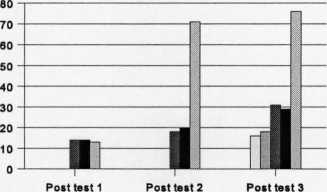of the words was calculated. Each group could get a maximum score of 104 for each post
test. Figures 7.11 and 7.12 present the results for both sets of questions.
Figure 7.11 Total number of correct responses in the “categorisation questions” by
group across testing

I I Control LJ PhO-ControI
I Oste-Definition H Lex-Contrast
і j Definition
Figure 7.12 Total number of correct responses in the “world knowledge” questions by
group across testing

Posttestl Post test 2 Post test 3
I I Control Fl Pho-Control
S Oste-Deflnltion H Lex-Contrast
I___: Definition
The previous figures show the same pattern as that shown in Table 7.11, nevertheless, to a
lower degree. In addition, comparison between the two sets of questions revealed that the
children performed significantly better in the “world knowledge" than the “categorisation"
questions across testing (Wilcoxon, Pl: Z=5.8, p<.0000; P2: Z= 4.7, p<.0000; P3: Z=8.1,
p<.0000).
Is there a differential impact of the type of exposure to new lexical items that the children
receive on their performance in the short questions task ?
Categorisation questions
Three separate One Way Analyses of Variance were carried out with group as the
independent variable and score in the categorisation questions as the dependent variables.
227
More intriguing information
1. The name is absent2. A Pure Test for the Elasticity of Yield Spreads
3. The name is absent
4. Developing vocational practice in the jewelry sector through the incubation of a new ‘project-object’
5. The name is absent
6. A Principal Components Approach to Cross-Section Dependence in Panels
7. Tobacco and Alcohol: Complements or Substitutes? - A Statistical Guinea Pig Approach
8. TINKERING WITH VALUATION ESTIMATES: IS THERE A FUTURE FOR WILLINGNESS TO ACCEPT MEASURES?
9. Restructuring of industrial economies in countries in transition: Experience of Ukraine
10. INSTITUTIONS AND PRICE TRANSMISSION IN THE VIETNAMESE HOG MARKET